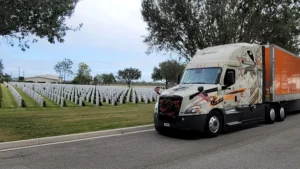WASHINGTON — As construction season ramps up, the Federal Highway Administration (FHWA) is urging drivers to slow down to help prevent fatalities in areas where work crews are on job sites.
This comes as the agency highlights this year’s National Work Zone Awareness Week, which runs April 15-19.
Tragically, three highway workers were killed on April 17 after a truck hit them along Interstate 83 in Philadelphia, hammering home the importance of work zone safety.
Investigators said a 24-year-old man was driving a large box truck at about 3:25 a.m. when it struck a construction vehicle in a work zone, then hit the three workers on the shoulder.
While the investigation into this incident is ongoing, the FHWA says that speed often plays a significant role in causing vulnerable road user and automobile crash-related fatalities.
“Safer speeds are a key part of the U.S. Department of Transportation’s National Roadway Safety Strategy, established under Secretary Pete Buttigieg and the Biden-Harris administration, to address the safety crisis on our roadways,” an FHWA news release states.
On April 16, FHWA Associate Administrator for Operations Martin Knopp joined Maryland Lt. Gov. Aruna Miller, Maryland Department of Transportation (MDOT) Secretary Paul Wiedefeld and other state officials for this year’s National Work Zone Awareness Week kick-off event organized by MDOT.
The event took place along Interstate 695 in Baltimore County. where six workers were killed in March 2023 when a vehicle crashed into a road construction site.
Officials said this year’s theme — “Work zones are temporary. Actions behind the wheel can last forever” — underscores how critical it is for drivers to make safety a priority while driving through work zones.
The recent collapse of the Francis Scott Key Bridge in Baltimore is another tragic reminder that highway construction workers are often the unsung heroes of the nation’s transportation system.
“We count on construction workers to keep our roads safe — and they count on all of us to keep them safe on the job,” said U.S. Deputy Transportation Secretary Polly Trottenberg. “In 2022, almost 900 people tragically lost their lives in work zone crashes. So this National Work Zone Awareness Week, we call on all drivers to slow down and pay attention. Our nation’s roadway workers are counting on you.”
Crashes in highway work zones happen most frequently when drivers are speeding or aren’t paying attention to changing road conditions. In 2022, speed was a factor in 34% of fatal work zone crashes. The National Work Zone Safety Information Clearinghouse, operated by the American Road and Transportation Builders Association and the Texas A&M Transportation Institute in coordination with FHWA, has additional data on work zone fatalities.
“The men and women fixing our streets, highways and bridges are among the most vulnerable road users because their jobs require them to be on foot near oncoming traffic,” said Federal Highway Administrator Shailen Bhatt. “We hope drivers stay alert so these mothers, fathers, sons and daughters who are America’s transportation heroes can do their jobs without incident and arrive home safely when their shift is over.”
The Biden-Harris administration has provided funding through a number of programs that can be used to improve safety on roads where construction crews are at work. The Bipartisan Infrastructure Law provides significant resources to improve work crew and construction site safety, including $5 billion to local governments for the Safe Streets For All discretionary grant program and $15.6 billion in total funding to State DOTs under the Highway Safety Improvement Program.
The law provides additional funding and provisions that can improve work zone safety, including:
- A higher federal share — up to 100% — for certain projects that utilize innovative project delivery, including those that provide contingency funds to incorporate safety enhancements to work zones
- Work Zone Safety Grants Program funding, which has been used to train more than 124,000 field workers, and state, local and tribal personnel in nearly 4,500 courses, with more than $50 million provided to non-profit organizations and the National Work Zone Safety Information Clearinghouse
- Strengthening Mobility and Revolutionizing Transportation Grants, including one for $1.6 million that will be used by the Maryland Department of Transportation’s State Highway Administration to collect data via aerial systems to support real-time speed management in work zones.
FHWA, in conjunction with the Intelligent Transportation Systems Joint Program Office, the Bureau of Transportation Statistics and Federal Motor Carrier Safety Administrations, continues to support national deployment of the Work Zone Data Exchange (WZDx), which can be used to streamline communication regarding work zone activity between agencies and traveler information service providers.
As of March 2024, 23 state agencies and the National Park Service are participating in the WZDx.
For more information on this year’s National Work Zone Awareness Week, visit National Work Zone Awareness Week, follow @USDOTFHWA on X and use hashtags #NWZAW, #Orange4Safety and #OrangeForSafety.
Born in Pine Bluff, Arkansas, and raised in East Texas, John Worthen returned to his home state to attend college in 1998 and decided to make his life in The Natural State. Worthen is a 20-year veteran of the journalism industry and has covered just about every topic there is. He has a passion for writing and telling stories. He has worked as a beat reporter and bureau chief for a statewide newspaper and as managing editor of a regional newspaper in Arkansas. Additionally, Worthen has been a prolific freelance journalist for two decades, and has been published in several travel magazines and on travel websites.
















I’ve got only one thing to say about this. It is poor warning ⚠️ signage ahead of the actual work site. as in a lack of properly controlled work site safety. acknowledging a road construction work site is a great idea. Yet the lack of prior notification is a big difference between the speed/distance to react time.